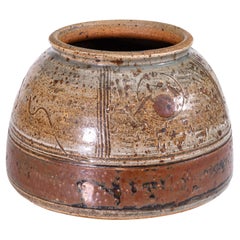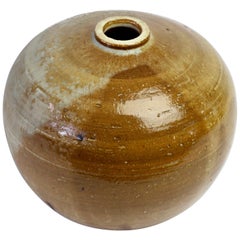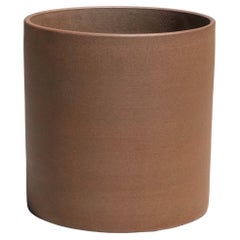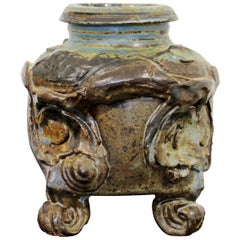John Glick Vases
to
1
1
1
1
1
1
1
Height
to
1
1
1
11
1,148
527
410
336
Creator: John Glick
John Glick Modernist Stoneware Glazed Ceramic Planter Vessel Plum Tree Pottery
By John Glick
Located in Keego Harbor, MI
A modernist stoneware glazed ceramic planter by Detroit artist John Glick of Plum Tree Pottery. Circa late 20th century. Glazed in earthtones. Artisisnal yet functional and makes a u...
Category
Mid-20th Century American John Glick Vases
Materials
Ceramic
Related Items
Vintage Glazed Signed European Art Studio Stoneware Pottery Vase or Vessel
Located in Landau an der Isar, Bayern
Beautiful brown salt glazed studio pottery vase or vessel. The piece is signed by the artist but we have not yet been able to identify them. Most cer...
Category
20th Century German Mid-Century Modern John Glick Vases
Materials
Stoneware
$1,074
H 5.12 in Dm 5.91 in
Architectural Pottery Cylinder Planter in Stoneware
By Architectural Pottery
Located in Los Angeles, CA
Architectural Pottery cylindrical planter in stoneware. The planter is in very good condition showing very little wear. One side shows a color variation in the material.
Structurall...
Category
Mid-20th Century American Mid-Century Modern John Glick Vases
Materials
Stoneware
$1,080 Sale Price
20% Off
H 18.5 in W 18.5 in D 18.5 in
Green Glazed Ceramic Water Jug Pottery Planter with Calligraphy
Located in Yonkers, NY
A richly glazed green ceramic jar with flared neck and raised calligraphic inscriptions. Striking for both its form and surface, this vessel features a rotund body tapering upward to...
Category
Late 20th Century Chinese John Glick Vases
Materials
Ceramic
Architectural Pottery Stoneware Cylindrical Planter
By Architectural Pottery
Located in Los Angeles, CA
Architectural Pottery cylindrical planter. The planter has a stoneware exterior and interior with a smaller cylindrical base.
Dimensions
18.5" diameter x 18.5" height
Condition
Exc...
Category
Mid-20th Century American Mid-Century Modern John Glick Vases
Materials
Stoneware
Stoneware Table Planter with Black Glaze
Located in Los Angeles, CA
Hand thrown stoneware table planter. The planter features a ribbed exterior with incised detail and a painted black glaze atop the unglazed vessel.
Signed "Slater" on the underside....
Category
Mid-20th Century American Mid-Century Modern John Glick Vases
Materials
Stoneware
Stoneware Table Planter with White Glaze
Located in Los Angeles, CA
Hand thrown stoneware table planter. The planter features a stoneware exterior with a white drip glaze and the interior of the planter is finished in an all over dark blue glaze.
Di...
Category
Mid-20th Century American Mid-Century Modern John Glick Vases
Materials
Stoneware
Architectural Pottery Stoneware Cylindrical Planter
By Architectural Pottery
Located in Los Angeles, CA
Architectural Pottery cylindrical planter. The CR16-15 planter has a stoneware exterior and interior with a smaller cylindrical base. Five planters available, priced individually.
D...
Category
Mid-20th Century American Mid-Century Modern John Glick Vases
Materials
Stoneware
Ceramic Vase, Glazed Stoneware Vase, Ciboure Pottery, France, circa 1950
By Ciboure
Located in New York, NY
Decorated by Pedro Garcia de Diego (1904-1969), this vase has an arabesque pattern in blacks and browns on a neutral ground. Marked and signed on base.
Category
1950s French Vintage John Glick Vases
Materials
Stoneware
$6,000
H 8.75 in W 4.25 in D 4.25 in
Ceramic Vessel with Geometrical Glaze by John Ward
By John Ward
Located in Atlanta, GA
A stoneware vessel with a distinct form and glaze by British studio potter John Ward (1938-2023) circa 1990s. This specific form in the artist's repertoire may be known as a "Spheric...
Category
Late 20th Century English Modern John Glick Vases
Materials
Ceramic
Two Tone Glazed Stoneware Planter
Located in Los Angeles, CA
Hand thrown stoneware glazed table planter. The planter features a beige and brown glazed exterior with stoneware interior.
Dimensions
7.25" diameter x 6.25" height.
Condition
Exce...
Category
Mid-20th Century American Mid-Century Modern John Glick Vases
Materials
Stoneware
John Glick Plum Street Pottery Ceramic Glazed Bowl/Charger Extra-large
By John Glick
Located in Bloomfield Hills, MI
The ceramic bowl is an example of the kind of work by which John Glick became so famous. He was seduced by the effects of the reduction kiln, which decreased the levels of oxygen during firing, inducing the flame to pull oxygen out of the clay and glazes changing the colors of the glazes depending on their iron and copper content. In this way he achieved the rich gradients of ochre and umber and variations in stippling and opacity. It is signed by the artist and stamped with Plum Street Pottery on the verso.
John was an American Abstract Expressionist ceramicist born in Detroit, MI. Though open to artistic experimentation, Glick was most influenced by the styles and aesthetics of Asian pottery—an inspiration that shows in his use of decorative patterns and glaze choices. He has said that he is attracted to simplicity, as well as complexity: my work continually reflects my re-examination that these two poles can coexist… or not, in a given series. Glick also took influences from master potters of Japan, notably Shoji Hamada and Kanjrio Kawai, blending their gestural embellishments of simple forms with attitudes of Abstract Expressionism. He was particularly drown to the work of Helen Frankenthaler whose soak-stain style resonated with Glick’s multi-layered glaze surfaces, which juxtaposed veils of atmospheric color with gestural marks and pattern. He spent countless hours developing and making his own tools in order to achieve previously unseen results in his work with clay and glaze.
Glick’s “Plum Tree Pottery” (now a designated historic landmark in Farmington Hills, Michigan) studio opened around 1965 and closed in the summer of 2016. It was a private studio space for John and a number of his students and assistants. He believed his shapes evolved guided by forces apparently outside his control. This was instinctual, intellectual and due to his openness to change, fusing into what he thought was the most positive force behind a potter’s approach: evolution and growth. Some have called it inspiration.
John was not only a major figure in the Detroit creative community, but in the ceramics world at large. According to Shelley Selim in her book on John, “John Glick: A Legacy in Clay” John remains: “one of the most recognizable names in the field of studio pottery – known for lecturing, publishing, and offering workshops widely – and his work has been featured in well over a hundred local, national and international exhibitions since he was a college student in the late 1950s.” Along with this John has mentored over thirty studio apprentices over five and a half decades, received numerous grants and awards for his work, and has been prolific, with an estimated 300,000 ceramic wares throughout the world.
He received his Masters from Cranbrook Academy of Art in Bloomfield Hills, Michigan, working with Maija Grotell, a legendary and influential teacher. Grotell was noted for her deep interest in the human connection to nature’s rhythms and patters. These ideas often grounded her dialog with her students including Glick, affecting, a profund and lasting influence on his future work. This famous Art Academy was designed by architect and faculty member, Eliel Saarinen who collaborated with Charles and Ray Eames on chair and furniture design. Numerous creative artists who are alumni of Cranbrook include: Harry Bertoia, Florence Knoll, Jack Lenor Larsen, Donald Lipski, Duane Hanson, Nick Cave, Hani Rashid, George Nelson, Urban Jupena (Nationally recognized fiber artist), Artis Lane (the first African-American artist to have her sculpture, "Sojourner Truth," commissioned for the Emancipation Hall in the Capital Visitor Center in Washington DC), Cory Puhlman (televised Pastry Chef extraordinaire), Thom O’Connor (Lithographs), Paul Evans (Brutalist-inspired sculpted metal furnishings), Eugene Caples (small bronze images/abstract), Morris Brose (Bronze Sculptures), Herb Babcock (blown glass), Larry Butcher (mixed media) and Lauren Anais Hussey...
Category
Late 20th Century American John Glick Vases
Materials
Ceramic
John Glick Plum Street Pottery Ceramic Charger Monumental
By John Glick
Located in Bloomfield Hills, MI
The ceramic charger is an example of the kind of work by which John Glick became so famous. He was seduced by the effects of the reduction kiln, which decreased the levels of oxygen during firing, inducing the flame to pull oxygen out of the clay and glazes changing the colors of the glazes depending on their iron and copper content. In this way he achieved the rich gradients of ochre and umber and variations in stippling and opacity. It is signed by the artist and stamped with Plum Street Pottery on the verso.
John was an American Abstract Expressionist ceramicist born in Detroit, MI. Though open to artistic experimentation, Glick was most influenced by the styles and aesthetics of Asian pottery—an inspiration that shows in his use of decorative patterns and glaze choices. He has said that he is attracted to simplicity, as well as complexity: my work continually reflects my re-examination that these two poles can coexist… or not, in a given series. Glick also took influences from master potters of Japan, notably Shoji Hamada and Kanjrio Kawai, blending their gestural embellishments of simple forms with attitudes of Abstract Expressionism. He was particularly drown to the work of Helen Frankenthaler whose soak-stain style resonated with Glick’s multi-layered glaze surfaces, which juxtaposed veils of atmospheric color with gestural marks and pattern. He spent countless hours developing and making his own tools in order to achieve previously unseen results in his work with clay and glaze.
Glick’s “Plum Tree Pottery” (now a designated historic landmark in Farmington Hills, Michigan) studio opened around 1965 and closed in the summer of 2016. It was a private studio space for John and a number of his students and assistants. He believed his shapes evolved guided by forces apparently outside his control. This was instinctual, intellectual and due to his openness to change, fusing into what he thought was the most positive force behind a potter’s approach: evolution and growth. Some have called it inspiration.
John was not only a major figure in the Detroit creative community, but in the ceramics world at large. According to Shelley Selim in her book on John, “John Glick: A Legacy in Clay” John remains: “one of the most recognizable names in the field of studio pottery – known for lecturing, publishing, and offering workshops widely – and his work has been featured in well over a hundred local, national and international exhibitions since he was a college student in the late 1950s.” Along with this John has mentored over thirty studio apprentices over five and a half decades, received numerous grants and awards for his work, and has been prolific, with an estimated 300,000 ceramic wares throughout the world.
He received his Masters from Cranbrook Academy of Art in Bloomfield Hills, Michigan, working with Maija Grotell, a legendary and influential teacher. Grotell was noted for her deep interest in the human connection to nature’s rhythms and patters. These ideas often grounded her dialog with her students including Glick, affecting, a profund and lasting influence on his future work. This famous Art Academy was designed by architect and faculty member, Eliel Saarinen who collaborated with Charles and Ray Eames on chair and furniture design. Numerous creative artists who are alumni of Cranbrook include: Harry Bertoia, Florence Knoll, Jack Lenor Larsen, Donald Lipski, Duane Hanson, Nick Cave, Hani Rashid, George Nelson, Urban Jupena (Nationally recognized fiber artist), Artis Lane (the first African-American artist to have her sculpture, "Sojourner Truth," commissioned for the Emancipation Hall in the Capital Visitor Center in Washington DC), Cory Puhlman (televised Pastry Chef extraordinaire), Thom O’Connor (Lithographs), Paul Evans (Brutalist-inspired sculpted metal furnishings), Eugene Caples (small bronze images/abstract), Morris Brose (Bronze Sculptures), Herb Babcock (blown glass), Larry Butcher (mixed media) and Lauren Anais Hussey...
Category
1990s American Expressionist John Glick Vases
Materials
Ceramic
Previously Available Items
Mid-Century Modern John Glick Signed Handmade Pottery Ceramic Footed Vase 1960s
By John Glick
Located in Keego Harbor, MI
For your consideration is a gorgeous, handmade, ceramic, footed art vase, signed on the bottom by John Glick, circa 1960s. In excellent condition. The dimensions are 6" diameter x 7"...
Category
1960s American Mid-Century Modern Vintage John Glick Vases
Materials
Ceramic
John Glick vases for sale on 1stDibs.
John Glick vases are available for sale on 1stDibs. These distinctive items are frequently made of ceramic and are designed with extraordinary care. There are many options to choose from in our collection of John Glick vases, although brown editions of this piece are particularly popular. If you’re looking for additional options, many customers also consider vases by Robert Maxwell, Blenko, and Winslow Anderson. Prices for John Glick vases can differ depending upon size, time period and other attributes — on 1stDibs, these items begin at $700 and can go as high as $700, while a piece like these, on average, fetch $700.



